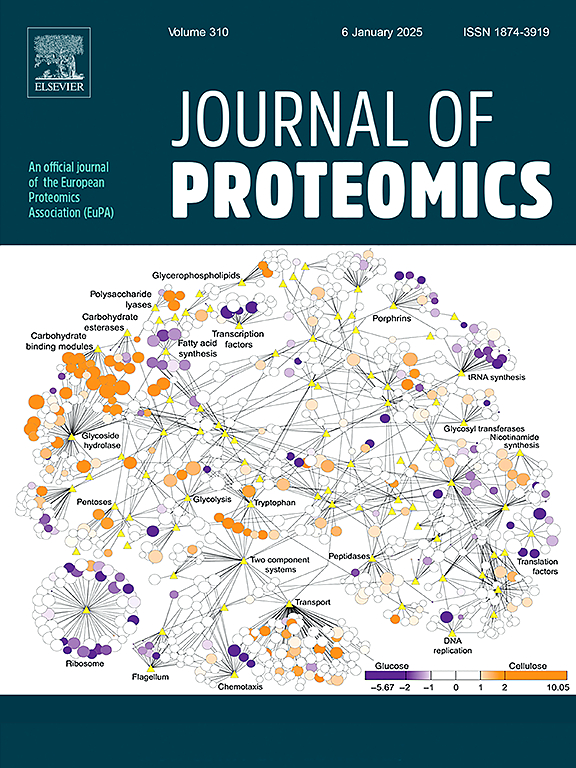过氧还蛋白6 (Prdx6)和氧化应激在死后牛肉嫩化:蛋白质组学的观点。
IF 2.8
2区 生物学
Q2 BIOCHEMICAL RESEARCH METHODS
引用次数: 0
摘要
本研究探讨了过氧化物还蛋白6 (Prdx6)介导的非硒谷胱甘肽过氧化物酶(NSGPx)活性在牛肉死后老化过程中调节嫩化过程的作用,延长至168 h。用过氧化氢(H2O2)、n-乙酰半胱氨酸(NAC)、巯基琥珀酸(MA)或生理盐水(对照)处理牛肉腰最长肌,分析剪切力、NSGPx活性、差异蛋白丰度、热休克蛋白(HSP70、HSP27)和肌钙蛋白- t水平。与NAC相比,MA处理抑制了NSGPx活性,加速了嫩化。蛋白质组学显示,死后0和24 h之间差异丰富的蛋白质与细胞骨架、细胞外基质、氨基酸代谢和凋亡途径有关。MA上调HSP70丰度、氧化应激和肌钙蛋白- t分解。H2O2仅在死后6-12 h内上调HSP70和HSP27的含量。这些结果表明,氧化应激处理在衰老过程中调节蛋白质动态,为提高牛肉嫩度的策略提供了见解。意义:本研究强调了过氧化物还蛋白6 (Prdx6)作为一个关键的调控元件,影响死后牛肉老化过程中涉及肉嫩化过程的氧化应激相关途径。我们证明,用巯基琥珀酸(MA)抑制Prdx6对硒谷胱甘肽过氧化物酶(NSGPx)的酶活性可以增加HSP70的丰度,并通过增强氧化应激和钙信号通路加速肌钙蛋白- t蛋白水解。相反,抗氧化剂n -乙酰半胱氨酸(NAC)通过保持细胞骨架的完整性来延缓嫩化。我们基于tmt的蛋白质组学进一步鉴定了35个连接细胞外基质重塑、氨基酸代谢和细胞凋亡与柔嫩调节的核心蛋白。这些发现提供了第一个机制证据,表明有针对性地操纵Prdx6活性可以优化牛肉的老化效率。对于肉类行业来说,MA处理提供了一种科学驱动的策略,可以在死后24-72 小时内将嫩化时间缩短20% %,降低加工成本,同时保持质量。这项工作还建立了HSP70和肌钙蛋白-t降解作为实时监测肉类加工系统氧化应激的新型生物标志物。本文章由计算机程序翻译,如有差异,请以英文原文为准。

Peroxiredoxin 6 (Prdx6) and oxidative stress in post-mortem beef tenderization: A proteomic perspective
This research explored the role of peroxiredoxin 6 (Prdx6)-mediated non‑selenium glutathione peroxidase (NSGPx) activity in modulating the tenderization process of beef during post-mortem aging, extending up to 168 h. Shear force, NSGPx activity, differential protein abundance, heat shock proteins (HSP70, HSP27), and troponin-T levels were analyzed in beef longissimus lumborum muscles treated with hydrogen peroxide (H2O2), N-acetylcysteine (NAC), mercaptosuccinic acid (MA), or saline (Control). MA treatment inhibited NSGPx activity and accelerated tenderization compared to NAC. Proteomics revealed that proteins differentially abundant between 0 and 24 h post-mortem were linked to cytoskeleton, extracellular matrix, amino acid metabolism, and apoptosis pathways.MA upregulated HSP70 abundance, oxidative stress, and troponin-T breakdown. H2O2 upregulated HSP70 and HSP27 abundance only within 6–12 h post-mortem. These results demonstrate that oxidative stress treatments modulate protein dynamics during aging, offering insights into strategies to enhance beef tenderness.
Significance
This study highlights peroxiredoxin 6 (Prdx6) as a crucial regulatory element that affects oxidative stress-associated pathways involved in the meat tenderization process during post-mortem beef aging. We demonstrate that inhibiting Prdx6's on‑selenium glutathione peroxidase (NSGPx) enzymatic activity with mercaptosuccinic acid (MA) increases HSP70 abundance and accelerates troponin-T proteolysis through enhanced oxidative stress and calcium signaling pathways. Conversely, antioxidant N-acetylcysteine (NAC) delays tenderization by preserving cytoskeletal integrity. Our TMT-based proteomics further identifies 35 core proteins linking extracellular matrix remodeling, amino acid metabolism, and apoptosis to tenderness modulation. These findings provide the first mechanistic evidence that targeted manipulation of Prdx6 activity can optimize beef aging efficiency. For the meat industry, MA treatment offers a science-driven strategy to reduce tenderization time by >20 % within 24–72 h post-mortem, lowering processing costs while maintaining quality. This work also establishes HSP70 and troponin-T degradation as novel biomarkers for real-time monitoring of oxidative stress in meat processing systems.
求助全文
通过发布文献求助,成功后即可免费获取论文全文。
去求助
来源期刊

Journal of proteomics
生物-生化研究方法
CiteScore
7.10
自引率
3.00%
发文量
227
审稿时长
73 days
期刊介绍:
Journal of Proteomics is aimed at protein scientists and analytical chemists in the field of proteomics, biomarker discovery, protein analytics, plant proteomics, microbial and animal proteomics, human studies, tissue imaging by mass spectrometry, non-conventional and non-model organism proteomics, and protein bioinformatics. The journal welcomes papers in new and upcoming areas such as metabolomics, genomics, systems biology, toxicogenomics, pharmacoproteomics.
Journal of Proteomics unifies both fundamental scientists and clinicians, and includes translational research. Suggestions for reviews, webinars and thematic issues are welcome.
 求助内容:
求助内容: 应助结果提醒方式:
应助结果提醒方式:


